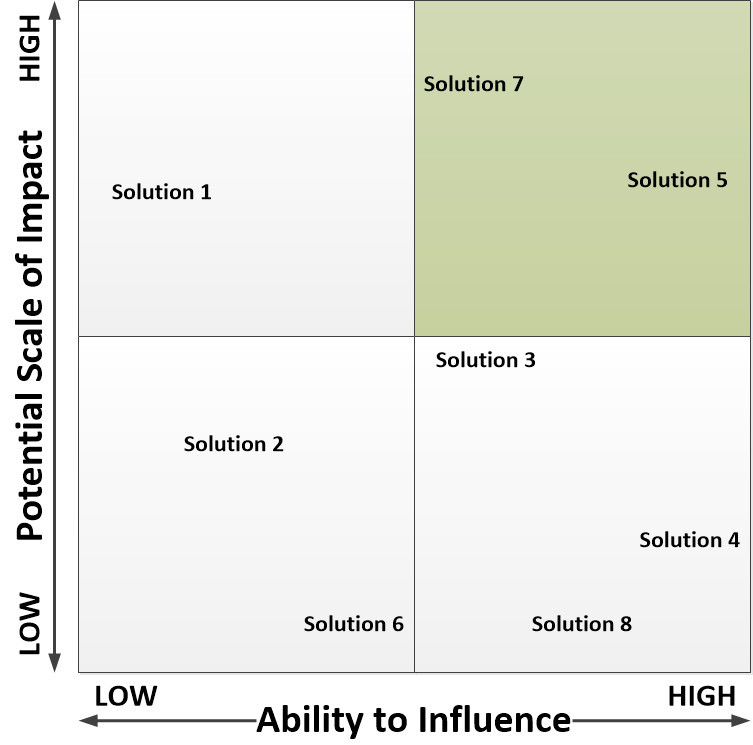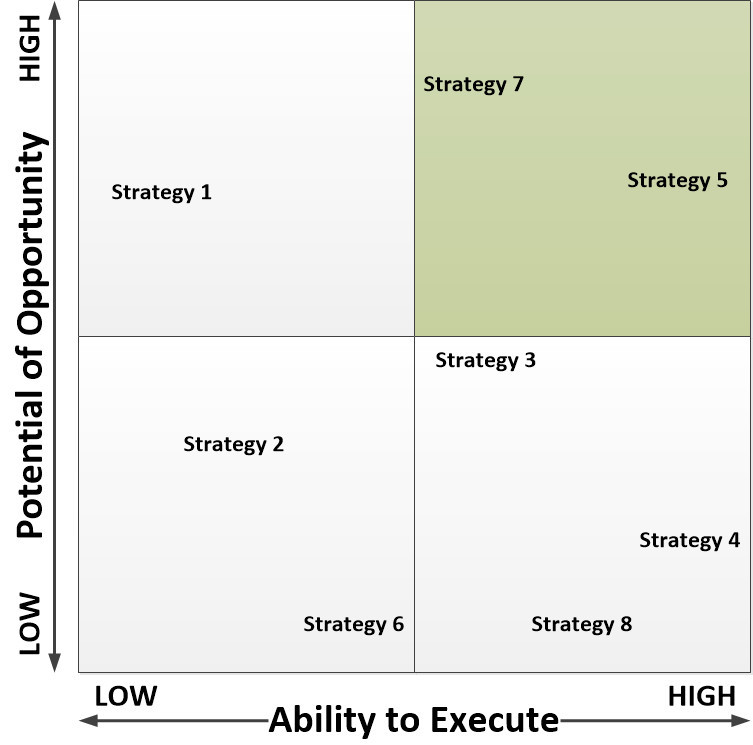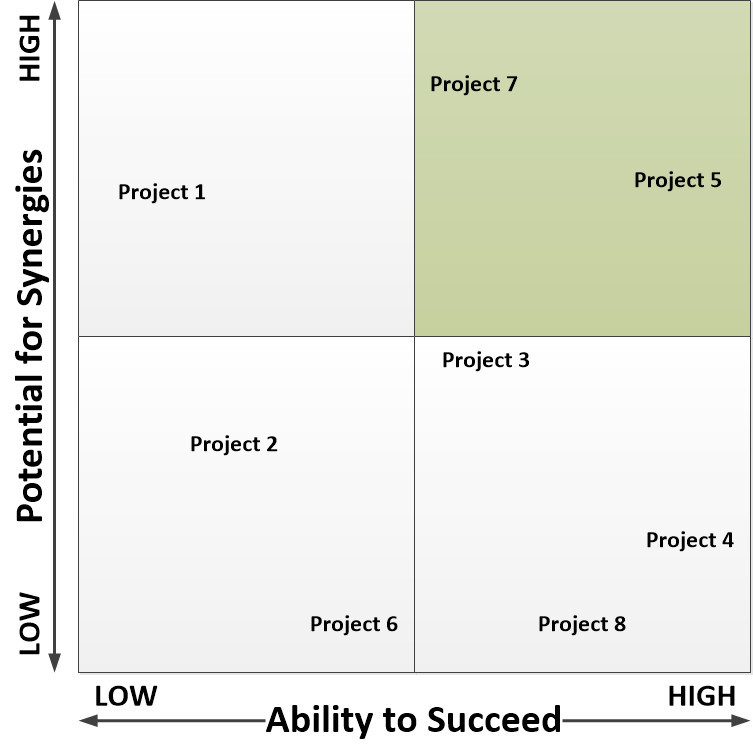This post lays out a simple way to identify the highest priority – or highest value – solutions to problems. It then extends that simple model from prioritizing solutions to prioritizing strategies and projects.
The best tools are usually the simplest, and that is the case with this simple prioritization matrix!
A Simple Prioritization Matrix

At its most basic, prioritization is all about identifying the possible solutions to our problem, identifying which will have an impact, and weighing our ability to influence each.
Let’s make a huge assumption here: you have a clearly defined problem. I know that often that is not true, and that defining the problem often times is half the battle. But this post is not about defining the problem; it’s about prioritizing solutions, given scarce resources.
For starters, the simple prioritization matrix at right has several solutions. They have been placed into the matrix according to:
- Potential Scale of Impact – This is a measure, on a scale from Low to High, of the potential impact of the solution.
- Ability to Influence – This measures our ability, as constrained by resources, talent, and time to solve all or part of the problem.
The region at the upper right of the graph is the sweet spot. It’s where the Potential Scale of Impact and the Ability to Influence are High. It’s where 20% of the effort – in terms of resources, talent, and time – will yield 80% of the results.
That’s the Pareto Principle. Here are some definitions of the Pareto Principle, depending upon where it is applied:
- 80:20 rule applied to investments
- 80:20 rule applied to personal achievement
- 80:20 rule applied to relationships
Here, we are applying the 80:20 rule, or Pareto Principle, to problem solving.
The Complexities – and Keeping It Simple
The graph shows possible solutions to the problem – placed in the appropriate position in the matrix. The power is in the simplification that the visualization provides. It shows values of the quadrants as follows:
- Low, Low – Solutions 2 and 6 have Low Ability to Influence and Low Potential Impact, and thus are the least favorable solutions.
- High, Low – Solutions 3, 4, and 8 are High on Ability to Influence, but Low on Potential Impact, and so they are less attractive solutions.
- Low, High – Solution 1 is Low on Ability to Influence, but High on Potential Impact, so it also is a sub optimal solution.
- High, High – Solutions 5 and 7, where the quadrant is highlighted in green, are good – 80:20 – potential solutions, as they have High Ability to Influence and High Potential Impact.
—————————————-
I recommend these PM templates (paid link):
—————————————-
Now let’s extend the simple prioritization matrix above and consider how it can be used – first for strategy prioritization, and then project prioritization.
Strategy Prioritization Matrix
 Strategy takes a different look at prioritization. Extending the idea of the simple prioritization above, the focus is not so much in coming up with solutions as coming up with potential strategies. Sometimes they are one and the same, but they can also be very different.
Strategy takes a different look at prioritization. Extending the idea of the simple prioritization above, the focus is not so much in coming up with solutions as coming up with potential strategies. Sometimes they are one and the same, but they can also be very different.
Instead of starting off with a list of potential solutions, you start with a set of potential strategies. In short, there are many directions you can go.
Similar to the simple prioritization matrix, the strategy prioritization matrix at right contains several strategies. They have been placed into the matrix according to:
- Potential of Opportunity – This is a measure, on a scale from Low to High, of the potential impact of the strategic opportunity.
- Ability to Execute – This measures our ability, as constrained by resources, talent, and time to execute any particular strategy.
The region at the upper right of the graph, where the Potential of the Opportunity and the Ability to Execute are High, is the sweet spot. It’s where 20% of the effort – in terms of resources, talent, and time – will yield 80% of the results from the strategic opportunities.
Project Prioritization Matrix
 The management of projects requires yet another variant of the simple prioritization matrix. Extending the idea of the matrices above, the focus is not so much in coming up with solutions as coming up with a way to prioritize projects. Portfolio management is somewhat of a combination of strategy and project prioritization.
The management of projects requires yet another variant of the simple prioritization matrix. Extending the idea of the matrices above, the focus is not so much in coming up with solutions as coming up with a way to prioritize projects. Portfolio management is somewhat of a combination of strategy and project prioritization.
Instead of starting off with a list of potential solutions, or a list of potential strategies, you start with a set of potential projects. There are many projects that you would like to get done, but how do you pick and choose the right ones, in combination, that should be done? And how do you determine when to do them?
Similar to both the simple and strategy prioritization matrices, the project prioritization matrix at right contains several projects. These are inputs to the project prioritization process. They have been placed into the matrix according to:
- Potential for Synergies – This is a measure, on a scale from Low to High, that characterizes projects by how they, when combined with other projects, produce a result that is greater than the sum of the results of the individual projects.
- Ability to Succeed – This measures the potential risk, or lack of risk, of each project. Risks have the potential to topple a good project, and part of the job in prioritization of projects is to increase chances of success. This also measures the capacity or capability of the organization to execute the projects, separately and together.
The region at the upper right of the graph, where the Potential for Synergies and the Ability to Succeed are High is the sweet spot. It’s where 20% of the effort – in terms of resources, talent, and time – will yield 80% of the results from the strategic opportunities.
Way Ahead and Further Resources
Note that there is no doctrine or standard on which the matrices above are based. The strategy and project matrices are simply my ideas and food for thought.
What ideas do you have on this? Do you think the dimensions of measurement for the strategy and project matrices are helpful? Do you think there are better ones?
Please comment below!
The following are related resources (these are paid links):


